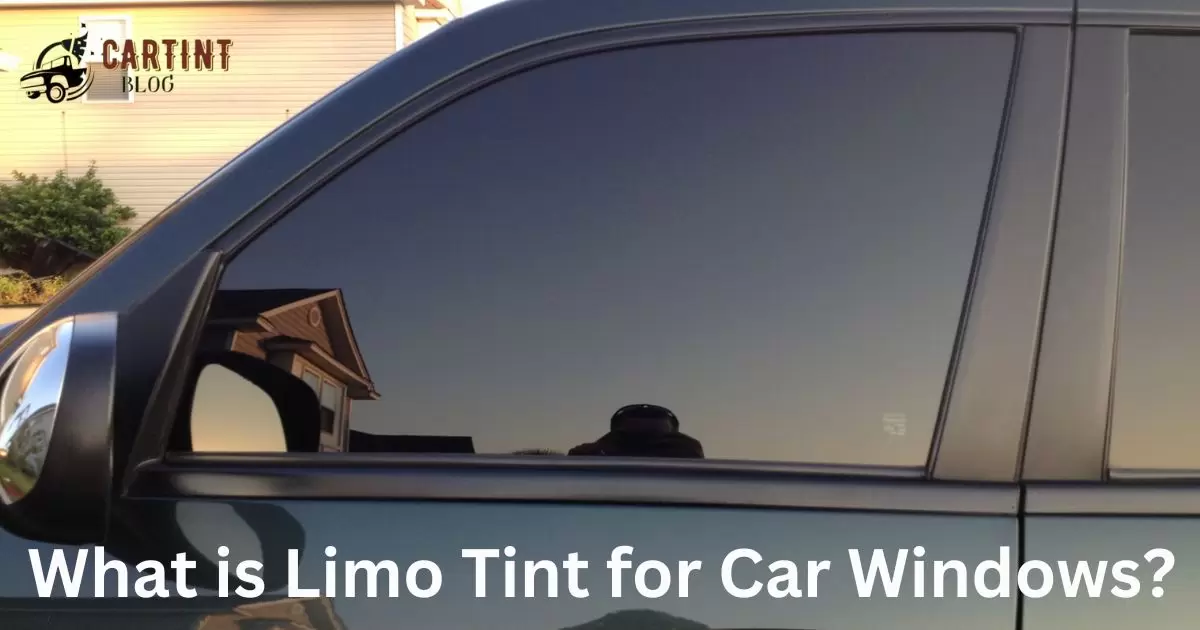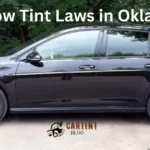What Is The Difference Between Dark Tint And Limo Tint?
Dark tint and limo tint are both terms used to describe window tinting that blocks light from entering a vehicle. The main difference lies in how much light each blocks, with limo tint blocking significantly more light than dark tint. Limo tint allows only 5% of incoming light to permeate, creating an opaque effect, while dark tint may allow 20% or more incoming light. Both offer privacy, UV protection, and heat reduction benefits.
When it comes to car window tint, many wonder “What is the difference between dark tint and limo tint?” The two sound similar, but have markedly different levels of darkness. Limo tint is an extremely dark shade, allowing only 5% of incoming light into a vehicle. Dark tint is darker than factory tint, but lighter than limo, typically allowing around 20% of light through. There are also key legal and visibility differences between the two.
Limo tint gets its name from its common usage on limousine windows, where maximum privacy is desired. It blocks 95% of incoming light, creating an opaque effect inside the vehicle. Dark tint provides added privacy over factory tint, while still allowing more light in than limo tint. Both limo and dark tints reduce heat, block UV rays, and enhance privacy, but limo does so to a greater extreme. Understanding these tint shades can help drivers make the right choice for their needs.
What is Limo Tint for Car Windows?
Limo tint blocks 95% of light for car windows. It only allows 5% of light to pass through. This creates an opaque effect inside the car. Limo tint is extremely dark window tinting. It is darker than factory tint or normal dark tint. Limo tint earns its name from use on limousine windows. The purpose is total privacy for passengers.
Limo tint goes beyond dark tint for car windows. It approaches a blackout effect on the glass. Limo tint also rejects heat and UV rays at very high levels. This protects skin and interiors. Limo tint obscures the car’s contents from outside view. This provides security and privacy benefits. Its main goal is to darken windows for a limousine-like atmosphere. However, many car owners wonder, Why don’t most people add privacy tints to their cars? Limo tint achieves maximum privacy inside cars.
How dark is limo car window tint?
Here are 5 benefits of limo car window tint:
- Limo tint blocks 95% of light. This creates maximum privacy inside the car. People cannot see inside.
- Limo tint reduces heat and glare very well. It keeps car interiors cooler on hot sunny days.
- Limo tint protects skin and interiors by blocking 99% of UV rays from the sun.
- Limo tint provides security by hiding valuables from view in the car’s trunk or cabin.
- Limo tint gives vehicles an aesthetic, sleek look with its dark opaque appearance on the glass.
What percentage of light does limo car tint block?
As an ultra-dark tint allowing only 5% of incoming light transmission, limo tint blocks 95% of light. This means it stops 95% of light, UV rays, and heat from entering the vehicle through the tinted windows. The 5% light transmission level gives limo tint its alternate name – “5% tint”. It has the lowest legal light transmission rate for any car window tint in most states.
With 95% of external light blocked from permeating the glass, limo tint creates an extremely dark environment inside the vehicle. Only a very small percentage of light passes through limo tinted windows, lending to limos’ private, opaque interiors. The 5% light transmission rate is the defining aspect of true limo tint.
Is limo car tint legal in all states?
No, limo tint is illegal for front driver and passenger side windows in many states due to the extreme limits it places on visibility. Most states restrict legal light transmission to a higher percentage for front windows since limo tint can dangerously obscure vision. However, some states allow limo tint on rear passenger windows within certain legal limits.
While many states prohibit limo tint on front driver and passenger windows, exceptions are sometimes granted for medical conditions or security reasons. However, in most cases the darkest legal tint for front windows is significantly lighter than limo tint, which only permits 5% of incoming light transmission. Rear window regulations are less strict in some states.
What are the benefits of using limo tint on car windows?
The ultra-dark nature of limo tint provides maximum privacy inside a vehicle, obscuring interior contents from external viewers. It also effectively blocks UV rays, slowing sun damage to skin and interiors. Limo tint keeps vehicle interiors significantly cooler as well by blocking 95% of solar radiation. The opaque darkness limo tint provides is its greatest benefit for those desiring privacy.
With its 5% light transmission allowance, limo tint excels at heat and UV light rejection. It keeps interiors cooler, upholstery protected, and occupants shaded. Limo tint also security by obscuring valuables from sight. Its signature benefit is the opaque darkness that earns it the “limo” designation and makes it popular on luxury vehicles seeking total privacy.
What is Dark Tint for Car Windows?
Dark tint refers to window film that blocks more incoming light than the factory tint on most car windows. It ranges from 20-35% visible light transmission (VLT), allowing 65-80% of light to be absorbed or reflected. This creates privacy while still enabling sufficient visibility. Dark tint enhances aesthetics, provides UV protection, and reduces glare and heat transmittance.
While exact percentages vary, dark tint films block significantly more light than the 70% VLT factory tint on most car windows from the manufacturer. They strike a balance between limo tint and clear film. Dark tinted windows have a noticeably darkened appearance, lending a sleek, sophisticated look.
How much light does dark tinted car windows block?
Dark tints block more light than factory tint, which typically has 70% VLT. Dark tint percentages can range from 20-35% VLT, meaning they block between 65-80% of incoming light. A 20% VLT film blocks 80% of light, allowing only 20% of visible light into the car. As the percentage goes up to 35% VLT, more light penetrates.
Compared to clear glass which allows over 90% of light through, dark tint films make a dramatic difference in light blockage. They absorb and reflect much more light than factory tint or clear windows, cutting transmittance significantly. The result is increased privacy, glare reduction, and heat control inside the car.
Is dark tint darker than factory car window tint?
Yes, dark tinted car windows are significantly darker than factory tints. Factory tint typically has 70% VLT, blocking only 30% of incoming light. In contrast, dark tints range from 20-35% VLT, blocking 65-80% of light—at least twice as much light blockage as factory films.
From the exterior of a vehicle, this difference in darkness is clearly visible. Factory tints have a light smoke appearance, while dark tints look noticeably opaque and obscured from outside a car. The increased pigmentation in dark tints is what enables them to better deflect light, glare, and solar radiation.
What percentage shade is dark tint for car windows?
Dark tinted car windows typically fall between 20-35% visible light transmission. A 20% VLT film is a charcoal black color and only allows 20% of incoming light into a vehicle, blocking 80%. As the percentage increases toward 35% VLT, the tint takes on a slightly lighter smoke shade and an increasing amount of light penetrates.
These percentages are darker than the average factory tint of 70% VLT. At the legal limit of 35% VLT, over twice as much light is still blocked compared to factory tints. The percentage chosen impacts appearance, visibility, and performance—with darker shades enhancing privacy, glare reduction, and cooling capacity.
Does dark tint keep car interiors cooler?
Yes, dark tinted windows play a significant role in keeping car interiors cooler in hot weather. By blocking 65-80% of incoming light, dark tints reduce the transmittance of solar radiation and infrared heat into a car interior. This decreased penetration of heat energy helps lower temperatures inside the vehicle.
The heat rejection and insulation provided by dark tints can reduce in-car temperatures by over 50°F compared to clear glass. By reflecting more sunlight, they cut heat buildup, helping stabilize interior temperatures for a more comfortable passenger environment. Darker tints perform even better than lighter tints for keeping interiors cooler.
Comparing Limo and Dark Car Window Tints
Limo tint blocks 95% of incoming light and allows just 5% transmission, making it extremely dark. Dark tint blocks less light, typically allowing around 20% transmission, so it is darker than factory tint but still allows more light through than limo tint. Both provide privacy, UV ray protection, and heat reduction, but limo tint offers these benefits to a greater extreme.
What’s the difference between 5% limo and 20% dark car tint?
The main difference lies in how much light each tint allows into the vehicle – 5% limo tint only allows 5% of light transmission, while 20% dark tint allows 20% light transmission, so dark tint is noticeably lighter than limo tint.
Which provides more UV protection – limo or dark car tint?
Limo tint blocks 95-99% of UV rays from entering the vehicle, while dark tint blocks approximately 80%, so limo tint provides more UV protection.
Which car window tint is darker – limo or dark smoke?
Limo tint is darker than dark smoke tint. Limo tint allows just 5% light transmission, creating an opaque effect, while dark smoke may allow 20% or more light through.
Can you still see out of limo vs. dark tinted car windows?
You can still see out of both limo and dark tinted windows, but visibility is more limited with limo tint since it blocks 95% of incoming light. Dark tint offers good visibility along with privacy and heat reduction benefits.
Are There Legal Limits for Limo vs Dark Car Tints?
There are legal limits on how dark of a tint is allowed for car windows. Limo tint, which blocks 95% of light, is illegal in many states. Georgia law allows a maximum tint of 32% visible light transmission for side windows. However, the law provides exemptions allowing darker tints for medical reasons with a doctor’s note.
Is limo car tint illegal in some states?
Yes, limo tint is illegal in several states, including Georgia, which only permits a maximum of 32% VLT for side passenger windows. Limo tint blocks 95% of light, far exceeding legal limits. Some states, like Arizona, permit limo tint, while others have total bans.
What’s the darkest legal car window tint percentage?
The darkest legal tint percentage varies by state, ranging from 20% VLT in states like Florida to 70% VLT in places like New York. Georgia permits 32% VLT on side passenger windows. However, exemptions allow darker tints.
Do laws differentiate between limo and dark smoke car tints?
Most state laws do not explicitly differentiate between limo and dark smoke tint. They simply provide a maximum percentage of allowable visible light transmission. However, limo tint, at 5% VLT, typically far exceeds legal limits, while dark smoke tints around 20% VLT may comply.
Can you get an exemption for medical or security reasons?
Yes, many states, including Georgia, provide exemptions to window tint laws for medical conditions and sometimes security reasons with proper documentation. Those with qualifying skin diseases, lupus, or similar light sensitivity issues may obtain a doctor’s note for darker tints.
Making the Best Choice for Your Car
When deciding between limo or dark tinted windows, consider your priorities. Limo tint blocks 95% of light and heat, provides nearly opaque privacy, and fully blocks UV rays. However, some states prohibit limo tint.
Dark tint blocks less light and heat than limo tint, still blocks 99% of UV rays, and provides substantial privacy, while complying with more state laws. Evaluate your needs for privacy, heat reduction, UV blocking, aesthetics, and legality when selecting between limo and dark tints. While limo tint is darker, both limo and dark window tints significantly reduce glare and heat, as well as block 99-100% of UV rays.
Limo tint blocks more incoming light, but also more outbound light at night. Dark tint strikes a balance between privacy and visibility. For privacy, limo tint cannot be beat, but for legality, visibility, and balanced performance, dark tinted windows may better suit your needs.
Should I choose limo or dark tinted windows for my car?
If privacy is your top concern, limo tint provides near complete opacity, blocking 95% of visible light. It creates cabin darkness and ensures no one can see inside. However, some states prohibit limo tint since it reduces visibility. If you prioritize legal compliance or visibility over complete privacy, choose dark tint, which still provides substantial privacy while meeting more state regulations.
For the darkest legal tint in most states, providing immense privacy, limo tint is an excellent choice. But if seeing out your windows at night or conforming to state laws are higher priorities, go with dark tint. Dark tint still blocks plenty of light for privacy while facilitating better visibility than limo tint.
What factors should guide my choice between limo and dark car tints?
Several things should guide picking between limo and dark tints. Look at privacy needs, laws, heat reduction, costs, and more. Limo tint gives the most privacy. But some states ban it. Both limo and dark tints block heat and UV rays. Dark tint costs less than limo.
It also meets more state laws. Drivers should weigh visibility needs too. Limo tint severely reduces night vision. Dark tint is safer for seeing at night. Overall, know your needs for privacy, heat blocking, laws, and visibility before choosing one.
| Factor | Limo Tint | Dark Tint |
| Privacy Level | Maximum privacy, 95% light blocked | Good privacy, 20-30% light blocked |
| Legality | Illegal in some states | Legal in more states |
| Heat/UV Blocking | Blocks ~100% of UV rays and heat | Blocks ~100% of UV rays and heat |
| Visibility | Severely reduced, especially at night | Good visibility at night |
| Cost | More expensive | Less expensive |
How do limo and dark tints compare on heat reduction and UV blocking?
Both limo and dark tinted windows provide significant heat reduction by blocking 95-99% of infrared rays. They also both block 99-100% of UV rays. So for heat and UV reduction, their performance is comparable. The main difference lies in visible light transmission – limo tint blocks far more visible light.
There is minimal difference between limo and dark tints regarding UV protection and heat reduction. Both reject 99% or more UV rays and infrared heat. However, limo tint blocks much more visible light – 95% versus dark’s 20-30% light blockage. So limo tint creates a darker interior, while both tints deliver similar thermal and UV protection.
Will limo or dark car tint work best to secure my privacy?
If complete privacy is your top concern, limo tint is undoubtedly the best choice. Blocking 95% of incoming light, limo tint allows virtually no ability to see inside your vehicle. It creates opaque, darkened cabin conditions. Dark tint, while still providing substantial privacy by blocking 20-30% of light, cannot match limo tint’s near-blackout levels of privacy.
Without question, limo tint provides superior privacy over dark tint. Limo tint blocks over 90% of visible light, making it impossible to see through the windows, while dark tint blocks only 20-30% of light. For the highest level of visual privacy inside your vehicle, limo tint is the most effective choice over dark window tint.
Frequently Asked Question
How much light does limo tint block?
Limo tint blocks 95% of visible light coming through car windows.
What percentage of light gets through dark tinted windows?
Dark tinted windows allow 20-30% of outside light to permeate the glass.
Which provides more privacy inside your car?
Limo tint offers maximum privacy by blocking 95% of light, making it impossible to see inside.
Do both limo and dark tints reject UV rays?
Yes, both limo and dark tints block 99-100% of harmful UV rays from entering through the glass.
Is it easier to see out of dark or limo tinted windows at night?
Dark tinted windows offer better visibility at night than limo tint which severely obscures vision in darkness.
Conclusion
In summary, limo tint and dark tint differ mainly in how much light they allow into a vehicle. Limo tint blocks 95% of visible light, creating near total darkness and privacy inside cars. It earns the limo name from use in limousines desiring opaque windows. Meanwhile, dark tint blocks only 20-30% of light, retaining good visibility yet increased privacy over untinted windows.
When choosing between the two for car windows, weigh factors like privacy needs, visibility, legality, costs, heat reduction, and aesthetics. Limo tint provides maximum privacy and heat blocking at a higher cost, while dark tint offers a better balance of good privacy, visibility, affordability and legal compliance. Know your priorities for car window tint darkness and performance before picking one over the other.




